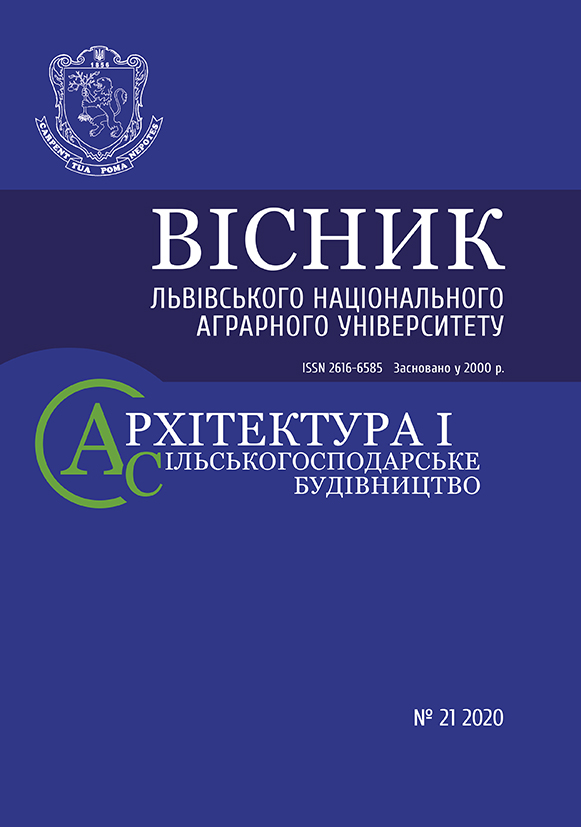Visnyk LNAU: Architecture and Farm Building 2019 №20: 70-76
ARCHITECTURE OF ECO SETTLEMENTS AS REFLECTION OF WORLDVIEW
Stepaniuk А., PhD of Architecture
Kiuntsli R., PhD of Philology
Lviv National Agrarian University
https://doi.org/10.31734/architecture2019.20.070
Annotation
The trend towards increasing the number of eco-settlements and demonstration of their importance often diverts attention from their true purpose.
After all, their main role is the preservation of natural environment and man as part of it. In addition to the important factors that make a settlement environmentally friendly (environmentally friendly building materials, the natural environment, the use of alternative energy sources, waste-free production), there is another factor - the preservation of man as a part of nature through his thinking, way of life, creative work.
It was proved that the highest level of harmony between man and nature was the creation of anthropogenic environment modeled after nature itself. Such environment was created by thinkers of the twentieth century Rudolf Steiner, Mirra Alfassa, Obert Araudi. These thinkers, despite their different beliefs and cultures, have created a solid foundation attracting other environmentalists. The core of their philosophy is a theoretical worldview, a teaching that seeks to substantiate the indispensability of man and nature, their interdependence, interchangeability.
A change in man’s moral landmarks often curtails his demiurgical capabilities and leads to change in priorities. The isolation of man from nature takes away from him a true understanding of the two dual principles of good and evil.
The return of humans to eco-settlements is an attempt to return to the world lost through the ontological gap. The architects of eco-buildings, through their philosophy, sought to deny the old dogma that philosophy can develop in only two ways: from things to ideas and from ideas to things.
They believed that both theories should be refined and validated.
Eco-architecture embodies ideas and philosophy of harmony with nature and itself. Unlike its previous counterparts ( the embodiment of the power and grandeur of the state in the empire, the embodiment of the unity of the earth and the sky in the Gothic, love for life and optimism in the Baroque, etc.) ecological architecture is a new phenomenon, one of the basic and fundamental aspects of human existence. Eco-architecture is not universal, it is not trying to become an alternative to modernity. It demonstrates a conceptual shift in our understanding of architecture.
Key words
Architecture, eco-settlements, harmony, worldview
Link
- Adams David Abstract for Rudolf Steiner's First Goetheanum a san Illustration of Organic Functionalism Journal of the Society of Architectural Historians 51,2 (June 1992). Р.182-204. https://doi.org/10.2307/990714
- Damanhur Philosophy. URL: http://www.damanhur.org/en/art-and-creativity/philosophy (accessed: 23.02. 2019).
- Damanhur. URL: https://wiki.yoga-vidya.de/Damanhur (accessed: 21.02. 2019).
- Damanhur. Artand Creativity. URL: http://www.damanhur.org/en/art-and-creativity (accessed: 22.03. 2019).
- Debbie Van Schyndel Kasper Redefining Community in the Ecovillage Human Ecology Review, Vol. 15, No. 1, 2008 Society for Human Ecology. P. 13 (12-24). URL: http://www.humanecologyreview.org/pastissues/her151/kasper.pdf (accessed: 22.07. 2019).
- Ramsey George H. Passiveen ergy applications for the built environment. URL: http://www.villagehabitat.com/resources/papers/passive_energy.pdf (accessed: 03.01. 2019).
- Adorno T. V. Aesthetic theory. Мoscov, 2001.
- Alekseenko Alexander. Auroville ‒ thecity of the future or where tobring dreams? URL: https://life-with-dream.org/aurovil-gorod-budushhego-ili-kuda-privodyat-mechty/ (accessed: 03.02.2019).
- Architecture and anthroposophy. Compiled and responsible editor Anna Sokolina. Moscow: «KMK Publishing House», 2001. 268 p.
- Architectural concepts of Matrimandir. Auroville. URL: http://auroville.ru/discover/structure/matrimandir/33-arkhitekturnaya-kontseptsiya-matrimandira (accessed: 02.02. 2019).
- Auroville: the strangest city on earth. The life of the planet National Geographic Russia. 11 February2016.URL: http://www.nat-geo.ru/planet/844502-aurovil-samyy-strannyy-gorod-na-zemle/ (accessed: 02.02. 2019).
- Belomesyatsev, A. B. Philosophical Foundations of Architectural / Institute for the Problems of the Modern Mycene of the Academy of Mystic Ukraine. Kyiv: MARI NAAU, 2005. 488 p.
- Gilman R. Eco-villages and sustainable settlements, Translation from English, Moscov 2000. URL: http://www.seu.ru/cci/lib/books/ecoderevni/index.htm (accessed: 02.02. 2019).
- Goryunova V. S., Porshneva V. P. «The Talking Architecture» by Rudolf Steiner. The architecture of the world. Materials conf. «Problems of the history of architecture». Moscow, 1992. P. 139–144.
- Kanarsky A. S. The dialectic of the aesthetic process: The dialectic of the aestheticas a theory of sensory cognition. Kyiv, 1979.
- Marder A. P. Aesthetics of architecture. Theoretical problems of architectural creativity. Moscow, 1988.
- Underground temples of Damanhur. Livejournal: іnternet-magazine. URL: https://masterok.livejournal.com/2976898.html (accessed: February 02.02. 2019).
- Puchkov A. O. Architecture Studiesand Cultural Studies: Selected Articles. Kyiv, 2005.
- Puchkov A. O. Poetry of the Ancient Architecture. Kyiv, 2008.
- Rappaport A. G., Somov G. Yu. Formin architecture: Problems of the oryand methodology. Moskow, 1991.
- Satprem «Mother's Agenda of the Mother's Conversation with Satprem». URL: http://integralyoga.ru/yoga/knigi/mother_books/agenda_materi (accessed: 02.02. 2019).
- Tubby M. P. Architecture of the Modern Age. Moskow: Stroyizdat, 1992.
- Heidegger M. Build – live – think. Translated by T. Wozniak. Texts and translations. Kharkiv, 1998.



